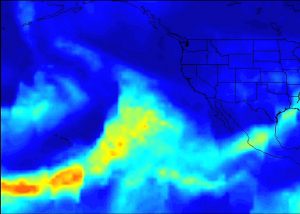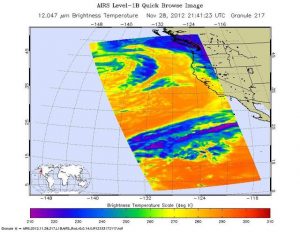3 August 2017
70-year record shows long-term trend in atmospheric river activity along U.S. West Coast
Posted by mjepsen
By Madeleine Jepsen
A new study has identified the climate variation patterns which exert the most influence on atmospheric river activity along the West Coast. One of these patterns is the long-term increasing trend associated with Pacific Ocean warming likely due to human activity.
The new study compiled an unprecedented seven-decade-long record of atmospheric river activity along the West Coast to explore variations in the climate and long-term trends in water vapor transport. These ephemeral rivers in the sky, called atmospheric rivers, are key transporters of water vapor from the tropics to the West Coast, and better understanding of their past activity will help improve seasonal and long-term forecasts, according to the study.
The new record indicates that water vapor transport over land, including that from atmospheric rivers, has been increasing in intensity over the past 70 years as the ocean surface warms. The study also finds last winter’s atmospheric rivers brought more moisture to California than the state has seen in any winter since at least 1948, and were instrumental in halting the historic California drought.
The increasing trend in water vapor transport had been hypothesized and identified in climate models projecting a warmer future. The new research shows it now has also been identified in a long record spanning much of the recent historical warming.
“For the first time, we have clearly seen an observed increase in the intensity of atmospheric river activity hitting the west coast of North America, and that’s a trend that is evident over the entire period of record,” said Alexander Gershunov, an associate research meteorologist at the Scripps Institution of Oceanography at the University of California San Diego, and lead author of the new study published in Geophysical Research Letters, a journal of American Geophysical Union.
The new record, decades longer than previous studies, allowed scientists to uncover links between warmer oceans, increased water vapor transport in the atmosphere and atmospheric rivers, and tease out climate change-related trends.
The long record clearly shows the long-term trend in atmospheric rivers and overall water vapor transport across the Pacific. Increased sea surface temperatures associated with climate change are bringing more moisture to the Western United States, the new study finds.

Anton Gershunov spins artist Oscar Romo’s mixed-media sculpture depicting atmospheric river activity around the world.
Credit: Alexander Gershunov
However, the new research shows the effect of increased sea surface temperatures on atmospheric river activity and water vapor transport due to human activity is small compared to the effects of natural climate variations. One such natural variation is the Pacific Decadal Oscillation (PDO), a long-term fluctuation in the Pacific Ocean. When these natural fluctuations in atmospheric river activity are accounted for, the increasing trend consistent with human-caused warming clearly emerges, Gershunov said.
The new study finds variations in Pacific sea surface temperatures, along with the Pacific Decadal Oscillation and a so-called “blob” of recent warming off the Pacific Northwest coast, have more impact on atmospheric river activity than El Niño-Southern Oscillation (ENSO), the best-recognized natural climate pattern in the Pacific, which has warm and cold events that occur every two to seven years.
Atmospheric river activity will likely continue to increase many years into the future, causing increasingly intense precipitation, which could result in more flooding and landslides as well as other challenges for water resource management, Gershunov said.
The new findings may also allow for more accurate seasonal and long-term forecasts of precipitation in the West by determining which climate variation patterns exert the most control over coastal atmospheric river activity.
“This gives us hope that perhaps atmospheric-river related rainfall — the most extreme events typically — may be more predictable,” Gershunov said.
Predicting atmospheric river activity
Atmospheric rivers transport water vapor across great distances of more than 1500 kilometers (932 miles) in transient, river-like streams in the lower troposphere. Atmospheric rivers travel over the Pacific Ocean, producing heavy rainfall and snowfall when they pass over West Coast mountain ranges.
About half of the total annual precipitation is delivered to the coastal areas of the Western states by a handful of atmospheric rivers. Because of this, the ability to forecast atmospheric river rainfall and snowfall for the next season as well as in future decades is important for the West, according to the study’s authors. To quantify the climate-scale variations including trends in atmospheric river activity, a decades-long record was needed. The research team created a 70-year catalog of atmospheric river activity using re-analyzed measurements of water vapor transport, which was examined in conjunction with measurements of precipitation and sea surface temperatures.
Atmospheric rivers transport and gain moisture as they travel over the ocean. The warmer the ocean, the warmer the overlying atmosphere is, and more evaporation occurs, since the warmer atmosphere has a larger capacity for carrying moisture. Atmospheric rivers pick up this additional moisture, and unleash more extreme rain and snowstorms once they hit the coast.
The researchers found warmer oceans are associated with more intense atmospheric river activity, which leads to more extreme precipitation. Sea surface temperatures worldwide have increased by about 1 degree Fahrenheit (about 0.5 degrees Celsius) since the late 1940s as a result of climate change, and the Pacific Ocean has been warming at the same pace. Previous research has shown the warmer sea surface temperature patterns highlighted by this study are a result of global warming from human activity.
The authors also used the longer record to tease out other patterns in atmospheric river activity. Previous records of atmospheric river activity along the West coast extended only to the 1970s and only captured one complete phase of the Pacific Decadal Oscillation, a natural climate pattern with warm and cool phases appearing to last 20-30 years based on the current record.
Along with other patterns of climate variation, the Pacific Decadal Oscillation (PDO) has been shown by the new study to strongly affect atmospheric river activity. The effect of the PDO on atmospheric rivers is so far much larger than the effect of gradually warming oceans due to human activity, according to the new study.
“By looking at our shorter records of 15-20 years, it might look like there’s an upward trend that you might ascribe to global warming, but you wouldn’t necessarily be right because there are natural variations in the climate system with long timescales, such as the Pacific Decadal Oscillation,” said Duane Waliser, chief scientist for Earth Science and Technology Directorate at NASA’s Jet Propulsion Laboratory, who was not involved in the new research. “With a 70-year record, you can start to better distill the difference between these variations that are natural from those that are the trends.”
— Madeleine Jepsen is a science writing intern at AGU.




 GeoSpace is a blog on Earth and space science, managed by AGU’s Public Information staff. The blog features posts by AGU writers and guest contributors on all sorts of relevant science topics, but with a focus on new research and geo and space sciences-related stories that are currently in the news.
GeoSpace is a blog on Earth and space science, managed by AGU’s Public Information staff. The blog features posts by AGU writers and guest contributors on all sorts of relevant science topics, but with a focus on new research and geo and space sciences-related stories that are currently in the news.
Too bad they didn’t go all the way back to 1861. 70 years is a fairly short period of time and is basically one single PDO cycle.